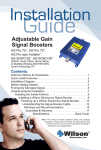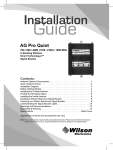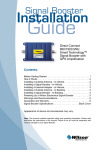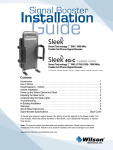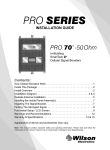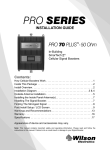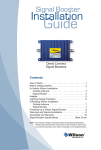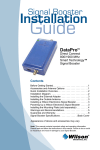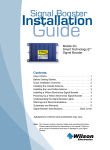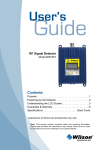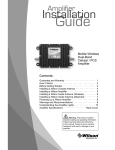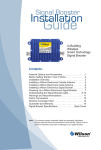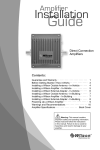Download Wilson Electronics 801201 TV signal amplifier
Transcript
Mobile Wireless Dual-Band Smart Technology ™ Signal Booster Contents: How it Works. . . . . . . . . . . . . . . . . . . . . . . . . . . . . . . . . . . 1 Before Getting Started. . . . . . . . . . . . . . . . . . . . . . . . . . . . 1 Quick Installation Overview. . . . . . . . . . . . . . . . . . . . . . . . 2 Installing the Outside Antenna. . . . . . . . . . . . . . . . . . . . . . 2 Installing the Low-Profile Antenna. . . . . . . . . . . . . . . . . . . 3 Installing a Wilson Electronics Signal Booster. . . . . . . . . . 3 Powering Up a Wilson Electronics Signal Booster . . . . . . 4 Understanding the Signal Booster Lights . . . . . . . . . . . . . 4 Warnings and Recommendations. . . . . . . . . . . . . . . . . . . 5 Guarantee and Warranty. . . . . . . . . . . . . . . . . . . . . . . . . . 6 Signal Booster Specifications . . . . . . . . . . . . . . Back Cover Appearance of device and accessories may vary. Note: This manual contains important safety and operating information. Please read and follow the instructions in this manual. Failure to do so could be hazardous and result in damage to your Signal Booster. Installation Instructions for the Following Wilson Electronics Signal Boosters: Mobile Wireless Dual-Band Smart Technology ™ Signal Booster Part # 801201, 801212, 801212F Model # 271201 FCC ID: PWO271201SA IC: 4726A-271201SA Model # 273201 FCC ID: PWO273201 IC: 4726A-273201 Mobile Wireless Dual-Band Smart Technology ™ Signal Booster Part # 801701, 801501, 801601, 801712 Model # 271701 NOT FOR SALE IN USA / CANADA The term “IC” before the radio certification number only signifies that Industry Canada technical specifications were met. Inside this Package DC plug-in power supply Signal Booster Optional Antennas (301127) Low-Profile Antenna (Included with some kits) (301103) Magnet Mount Dual-Band (Included with some kits) (301113) Mini Magnet Dual-Band (Included with some kits) (301101) Trucker Mount Tri-Band (301130) Marine Antenna Dual-Band (301104) NMO Mount Dual-Band Appearance of device and accessories may vary. Wilson Electronics manufactures a wide variety of antennas to help you customize your Signal Booster for your specific application. Several authorized antennas are shown above. See your dealer or visit www.WilsonElectronics.com. How it Works Your new Wilson Signal Booster has been carefully engineered to significantly improve the performance of your cell phone and cellular data card in mobile applications. Together with an Outside Antenna, the Signal Booster’s state-of-the-art technology is designed to increase your signal more than 20 times, reduces dropped calls and increase data communication rates needed for 3G technologies. The Outside Antenna will collect the cell tower signal and send it through the cable to the Signal Booster. The signal is then boosted and sent to the Inside Antenna. Your cellular device then communicates with the improved signal. When the cellular device transmits, the signal goes through the Inside Antenna, is boosted by the Signal Booster and transmitted to the cell tower through the Outside Antenna. Before Getting Started This guide will help you properly install your Wilson Electronics Dual-Band Mobile Wireless Signal Booster. It is important to read through all of the installation steps for your particular application prior to installing any equipment. Read through the instructions, visualize where all the equipment will need to be installed and do a soft installation before mounting any equipment. Contact Wilson Electronics Technical Support Team with any questions at 866-294-1660. 1 Contact Wilson Electronics’s Technical Support Team with any questions at 866-294-1660 Or email: [email protected] Mon.- Fri. Hours: 7am to 6 pm MST. Quick Installation Overview Installation Diagram ! Warning: In a wireless installation, do not plug the Signal Booster directly into the cell phone and/or data card using an antenna adapter. It may damage the Signal Booster, cell phone and/or data card. ! Warning: Do not plug in the DC power supply until the Outside and Inside Antenna cables are attached to the Signal Booster. Outside Antenna Distance between antennas through a sunroof must be 5 feet or more. Cell Phone PDA Notebook Inside Antenna DC Power Supply Signal Booster Installing the Outside Antenna To receive the best cell signal, select a location in the center of the vehicle’s roof 12 inches away from any other antennas or windows. If the vehicle has a sunroof, it is important to separate the Inside and Outside Antennas by at least five feet. This prevents the Signal Booster from overloading or oscillating. As shown above. Follow the specific antenna installation instructions included with the Outside Antenna. Magnet - Mount Antenna Shown Part #301103 Separation of the Inside and Outside Antennas is very important. The metal roof of the vehicle acts as a barrier and helps shield the two antennas from each other, preventing oscillation (feedback). The Outside Antenna must be installed vertically. Signal performance will be degraded if the antenna is not vertical. The antenna cable may run through the door to the Signal Booster. Carefully Pull Down Door Seal Run Cable Under Seal Tuck Cable Under Seal For a more professional looking installation, run the antenna cable under the door seal. The antenna cable is small enough to easily tuck under the door seal or plastic molding. Carefully pull down the door seal. Run the cable through the seal and push the seal back into place. This prevents constant wear and tear on the cable as the door opens and closes. ! Warning: The Outside Antenna must have a separation of at least 20 inches from all persons during normal operation. ! Warning: Do not use any type of glass-mount antenna with this Signal Booster. The Outside and Inside Antennas must be shielded from each other to prevent oscillation (feedback). Contact Wilson Electronics’s Technical Support Team with any questions at 866-294-1660 Or email: [email protected] Mon.- Fri. Hours: 7am to 6 pm MST. 2 Installing the Low-Profile Antenna ! Warning: Do not install the Low-Profile Antenna within four inches of metal. (Metal found inside the vehicle’s seat will not affect the antenna’s performance.) ! Warning: Do not plug in the DC power supply until the Outside and Inside Antenna cables are attached to the Signal Booster. Low-Profile Antenna Signal Booster Place the Low-Profile Antenna on the side of the driver’s seat for maximum performance. Install the Low-Profile Antenna at least eight inches, but not more than 12 inches, from where the cellular device will be used. Install the Low-Profile Antenna at the same angle as the cell phone when held in use, or place next to the laptop’s cellular data card. This will maximize the signal strength. For a more professional looking installation, the LowProfile Antenna may be slid under the seat cover or upholstery, high on the driver’s seat. ! Warning: The Inside Antenna must be installed with a separation of at least eight inches from all persons and must not be located in conjunction with any other antenna or Signal Booster. Installing a Wilson Electronics Signal Booster Select a location to install the Signal Booster that is away from excessive heat, direct sunlight, moisture and has proper ventilation. Run the cable from the Outside Antenna and attach it to the connector labeled “Outside Antenna” on the Signal Booster. Attach the Low-Profile Antenna cable to the connector labeled “Inside Antenna” on the Signal Booster. NOTE: The aluminum casing of a Wilson Signal Booster will adjust very quickly to the ambient temperature of its environment. For example, in the summer, when the inside of a car can reach 140 degrees Fahrenheit, the Signal Booster temperature may be 150 degrees or higher. The casing will be hot to the touch, similar to a metal door handle or a steering wheel. Such high temperatures will not damage the Signal Booster, nor do they pose a fire risk to the vehicle. As recommended in these instructions, install the Signal Booster in a location with adequate ventilation, such as under the seat or under the dashboard. Keep the area free of items that could block air flow to the Signal Booster. 3 Contact Wilson Electronics’s Technical Support Team with any questions at 866-294-1660 Or email: [email protected] Mon.- Fri. Hours: 7am to 6 pm MST. Powering up a Wilson Electronics Signal Booster Connect the power cable from the DC plug-in power supply to the Signal Booster marked “6 V DC” and insert the large end into DC power socket (the vehicle power adapter outlet). ON/OFF SWITCH The Signal Booster may remain on all the time. However, leaving the Signal Booster on in a vehicle when it is not running can discharge or drain the battery in a day or two. Switch the power supply off when not in use. A good option is to power the Signal Booster through the ignition switch so the Signal Booster is turned on and off with the vehicle. IMPORTANT: Do not power up the Signal Booster unless antenna cables are attached to Signal Booster. An available option to do this with is the Hardwire Kit from Wilson Electronics. # 859923. Understanding the Signal Booster Lights The power light will turn green when the Signal Booster is successfully powered up. When the 800 MHz or 1900 MHz lights are lit green, the Signal Booster is amplifying the outside signal. All green lights If one or both frequency lights turn red, oscillation is occurring and the Signal Booster has powered down on the frequency with the red light to prevent oscillation. The Outside Antenna needs to be moved farther from the Inside Antenna. Move the Outside Antenna on the roof of the car to the rear of the car, but at least 8-12 inches from the rear or side windows. Disconnect power from the Signal Booster and reconnect power. This resets the Signal Booster. If the lights are now green, the Signal Booster is working properly. If the red light is still on, move the antenna farther away and repeat the process. Red light on frequency indicator Always use a magnet-mount or roof-mount antenna. Do not use a glass-mount antenna, as oscillation may cause continuous shut-down of the Signal Booster. An amber light in either the 800 MHz or 1900 MHz position indicates overload from the cell tower. The Signal Booster has temporarily shut down and will automatically reset when overload is no longer detected. Amber light on frequency indicator Contact Wilson Electronics’s Technical Support Team with any questions at 866-294-1660 Or email: [email protected] Mon.- Fri. Hours: 7am to 6 pm MST. 4 Warnings and Recommendations Warning: In a wireless installation, do not plug the Signal Booster directly into the cell phone or cellular data card using an antenna adapter. It will damage the Signal Booster, cell phone or cellular data card. Warning: Do not plug in the DC power supply until the Outside and Inside Antenna cables are attached to the Signal Booster. Warning: RF Safety: The Inside Antenna must be installed with a separation of at least 8 inches from all persons and must not be located in conjunction with any other antenna or Signal Booster. Warning: RF Safety: The Outside Antenna must be installed with a separation of at least 20 inches from any of the vehicle’s occupants or nearby persons and must not be located or operating in conjunction with any other antenna or Signal Booster. All roof mount antennas should be centrally located on the roof of the vehicle. Mirror-mount antennas should be mounted as high above the roof line as possible and leave at least 20 inches of separation from any persons near or around the vehicle. Warning: Use only the power supply provided in this package. The power supply must be 6 V DC Output. This device complies with Part 15 of FCC rules. Operation is subject to two conditions: (1) This device may not cause harmful interference, and (2) this device must accept any interference received, including interference that may cause undesired operation. Changes or modifications not expressly approved by Wilson Electronics could void the authority to operate this equipment. About Wilson Electronics Wilson Electronics, Inc. has been a leader in the wireless communications industry for over 40 years. The company designs and manufactures Signal Boosters, antennas and related components that significantly improve cell phone signal reception and transmission in a wide variety of applications, both mobile, M2M and in-building. With extensive experience in antenna and Signal Booster research and design, the company’s engineering team uses a state-of-the-art testing laboratory, including an anechoic chamber and network analyzers, to fine-tune antenna designs and performance. For its Signal Boosters, Wilson Electronics uses a double electrically shielded RF enclosure and cell tower simulators for compliance testing. Wilson Electronics Signal Boosters feature patent-pending Smart Technology ™ that enables them to automatically adjust their power based on cell tower requirements. By detecting and preventing oscillation (feedback), signal overload and interference with other users, these Smart Technology ™ Signal Boosters improve network cell phone areas without compromising carrier systems. All products are engineered and assembled in the company’s 55,000-square-foot headquarters in St. George, Utah. Wilson Electronics has product dealers in all 50 states as well as in countries around the world. 5 Contact Wilson Electronics’s Technical Support Team with any questions at 866-294-1660 Or email: [email protected] Mon.- Fri. Hours: 7am to 6 pm MST. 30-Day Money-Back Guarantee All Wilson Electronics products are protected by Wilson Electronics 30-day money-back guarantee. If for any reason the performance of any product is not acceptable, simply return the product directly to the reseller with a dated proof of purchase. 1-Year Warranty Wilson Electronics Signal Boosters are warranted for one (1) year against defects in workmanship and/or materials. Warranty cases may be resolved by returning the product directly to the reseller with a dated proof of purchase. Signal Boosters may also be returned directly to the manufacturer at the consumer’s expense, with a dated proof of purchase and a Returned Material Authorization (RMA) number supplied by Wilson Electronics. Wilson Electronics shall, at its option, either repair or replace the product. Wilson Electronics will pay for delivery of the repaired or replaced product back to the original consumer within the continental U.S.. This warranty does not apply to any Signal Boosters determined by Wilson Electronics to have been subjected to misuse, abuse, neglect, or mishandling that alters or damages physical or electronic properties. RMA numbers may be obtained by contacting Technical Support at 866-294-1660. Disclaimer: The information provided by Wilson Electronics, Inc. is believed to be complete and accurate. However, no responsibility is assumed by Wilson Electronics, Inc. for any business or personal losses arising from its use, or for any infringements of patents or other rights of third parties that may result from its use. Copyright © 2012 Wilson Electronics, Inc. All rights reserved. U.S. Patent Nos. – D565,021; 7,221,967; 7,729,669; 7,486,929; 7,409,186; 7,783,318 Contact Wilson Electronics’s Technical Support Team with any questions at 866-294-1660 Or email: [email protected] Mon.- Fri. Hours: 7am to 6 pm MST. 6 3301 East Deseret Drive, St. George, UT 84790 For additional Technical Support visit www.WilsonElectronics.com or email at: [email protected] Phone: 866-294-1660 Local: 435-673-5021 Fax: 435-656-2432 www.twitter.com/WilsonCellular www.facebook.com/WilsonCellular 110727_Rev30_07.12.12 20 dB Bandwidth (nominal) Power output (uplink) for multiple cell phones: Power output for multiple received channels (downlink). The maximum power is reduced by the number of channels: Number of channels 2 3 4 5 6 CDMA GSM EDGE -4.5 dBm -8.0 dBm -10.5 dBm -12.5 dBm -14.0 dBm 6 V, .5 A - 1.5 A (subject to uplink power) 1800 MHz 900 MHz 3.5 dB nominal > 90 dB Maximum Power 9.9 dBm 9.9 dBm 9.6 dBm -11.9 dBm -15.4 dBm -17.9 dBm -19.9 dBm -21.4 dBm 10.0 dBm 11.0 dBm 10.9 dBm 1800 MHz 23.1 dBm 19.6 dBm 17.1 dBm 15.1 dBm 13.6 dBm 28.1 dBm 24.6 dBm 22.1 dBm 20.1 dBm 18.6 dBm 900 MHz 1800 MHz Maximum Power 1800 MHz 33.0 dBm 32.2 dBm 32.1 dBm 900 MHz 900 MHz 34.7 dBm 35.6 dBm 34.6 dBm 53.5 MHz / 47.7 MHz 102 MHz / 96 MHz 37 dB 43 dB Dual Band Specifications 271701 FME-Male 50 ohms 4.5 x 3.5 x 1.25 inch or 11.43 x 8.9 x 3.2 cm 1.5 lbs or 0.7 kg 880-960 MHz / 1850-1990 MHz Notes: 1. Nominal gain is the maximum gain at any frequency in the passband. Average gains are: 37 dB (800 MHz uplink & downlink) 43 dB (1900 MHz uplink & downlink) 2. Nominal bandwidth is the difference between two frequencies that are adjacent to the passband where the amplification is 20 dB lower than the passband amplification. One of the frequencies is lower than the passband and the other is higher. 3. The Manufacturer’s rated output power of this equipment is for single carrier operation. For situations when multiple carrier signals are present, the rating would have to be reduced by 3.5 dB, especially where the output signal is re-radiated and can cause interference to adjacent band users. This power reduction is to be by means of input power or gain reduction and not by an attenuator at the output of the device. 4. The maximum power for 2 or more simultaneous signals will be reduced by 6 dB every time the number of signals is doubled. Noise Figure (typical) Isolation Power Requirements Signal Booster Usage 4 CDMA GSM EDGE Number of cell phones 2 3 4 5 6 Power output for single received channel (downlink) 3 Uplink Downlink 800 MHz (uplink/downlink) 1900 MHz (uplink/downlink) Power output for single cell phone (uplink) 2 Model Number Connectors Impedance (input/output) Dimensions Weight Frequency 1 Passband Gain (nominal) Signal Booster Specifications 20 dB Bandwidth (nominal) Maximum Power Notes: 1. Nominal gain is the maximum gain at any frequency in the passband. 2. Nominal bandwidth is the difference between two frequencies that are adjacent to the passband where the amplification is 20 dB lower than the passband amplification. One of the frequencies is lower than the passband and the other is higher. 3. The Manufacturer’s rated output power of this equipment is for single carrier operation. For situations when multiple carrier signals are present, the rating would have to be reduced by 3.5 dB, especially where the output signal is re-radiated and can cause interference to adjacent band users. This power reduction is to be by means of input power or gain reduction and not by an attenuator at the output of the device. 4. The maximum power for 2 or more simultaneous signals will be reduced by 6 dB for each doubling of the number of signals. 6 V, 0.5 A - 1.5 A (subject to uplink power) 9.6 dBm 6.0 dBm 3.5 dBm 1.6 dBm 0.0 dBm 1900 MHz 12.0 dBm 10.4 dBm +9.2 dBm 1900 MHz Signal Booster Usage 9.6 dBm 6.1 dBm 3.6 dBm 1.6 dBm .1 dBm 800 MHz 11.3 dBm 9.3 dBm 8.8 dBm 800 MHz 1900 MHz 21.4 dBm +21.2 dBm +18.9 dBm 17.0 dBm 15.4 dBm 3 dB nominal > 90 dB Number of channels 2 3 4 5 6 Maximum Power 800 MHz 1900 MHz 33.6 dBm 27.7 dBm 28.8 dBm 23.2 dBm 19.7 dBm 17.2 dBm 15.2 dBm 13.7 dBm 800 MHz 34.5 dBm 30.1 dBm 29.7 dBm 31 MHz 72 MHz 55 dB Dual Band Specifications 271201, 273201 FME-Male 50 ohms 5.6 x 3.6 x 1.7 inch or 14.2 x 9.1 x 4.4 cm 1.2 lbs or 0.54 kg 824-894 MHz / 1850-1990 MHz Noise Figure (typical) Isolation Power Requirements Power output for multiple received channels (downlink). The maximum power is reduced by the number of channels: 4 CDMA GSM EDGE Number of cell phones 2 3 4 5 6 Power output for single received channel (downlink) Power output (uplink) for multiple cell phones: 3 CDMA GSM EDGE 800 MHz (uplink/downlink) 1900 MHz (uplink/downlink) Power output for single cell phone (uplink) 2 Model Number Connectors Impedance (input/output) Dimensions Weight Frequency 1 Passband Gain (nominal) Signal Booster Specifications








